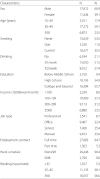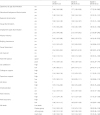1. Kivimaki M, Head J, Ferrie JE, Hemingway H, Shipley MJ, Vahtera J. Working while ill as a risk factor for serious coronary events: the whitehall II study. Am J Public Health. 2005; 95:98–102. DOI:
10.2105/AJPH.2003.035873. PMID:
15623867.
2. Aronsson G, Gustafsson K, Dallner M. Sick but yet at work. An empirical study of sickness presenteeism. J Epidemiol Community Health. 2000; 54:502–509. DOI:
10.1136/jech.54.7.502. PMID:
10846192.
5. Johansson G, Lundberg I. Adjustment latitude and attendance requirements as determinants of sickness absence or attendance. Empirical tests of the illness flexibility model. Soc Sci Med. 2004; 58:1857–1868. DOI:
10.1016/S0277-9536(03)00407-6. PMID:
15020004.
6. Turpin RS, Ozminkowski RJ, Sharda CE, Collins JJ, Berger ML, Billotti GM. Reliability and validity of the stanford presenteeism scale. J Occup Environ Med. 2004; 46:1123–1133. DOI:
10.1097/01.jom.0000144999.35675.a0. PMID:
15534499.
7. Hemp P. Presenteeism: at work-but out of it. Harv Bus Rev. 2004; 82:49–58. PMID:
15559575.
8. Johns G. Presenteeism in the workplace: a review and research agenda. J Organ Behav. 2010; 31:519–542. DOI:
10.1002/job.630.
9. Amick BC, Lerner D, William H, Rooney T, Jeffrey N. A review of health-related work outcome measures and their uses, and recommended measures. SPINE. 2000; 25(24):3152–3160. DOI:
10.1097/00007632-200012150-00010. PMID:
11124731.
11. Prasad M, Wahlqvist P, Shikiar R, Shih YT. A review of self-report instruments measuring health-related work productivity. Pharmacoeconomics. 2004; 22(4):225–244. DOI:
10.2165/00019053-200422040-00002. PMID:
14974873.
12. Ozminkowski RJ, Goetzel RZ, Chang S, Long S. The application of two health and productivity instruments at a large employer. J Occup Environ Med. 2004; 46:635–648. DOI:
10.1097/01.jom.0000131797.52458.c8. PMID:
15247802.
13. Stewart WF, Ricci JA, Chee EC, Morganstein D. Conditions in the united states: results from the American productivity audit. J Occup Environ Med. 2003; 45:1234–1246. DOI:
10.1097/01.jom.0000099999.27348.78. PMID:
14665809.
14. Hymel P, Loeppke R. Health and Productivity Toolkit. 2006. Elk Grove Village: American College of Occupational and Environmental Medicine.
15. Bergstrom G, Bodin L, Hagberg J, Aronsson G, Josephson M. Sickness presenteeism today, sickness absenteeism tomorrow? A prospective study on sickness presenteeism and future sickness absenteeism. J Occup Environ Med. 2009; 51:629–638. DOI:
10.1097/JOM.0b013e3181a8281b. PMID:
19448572.
16. Asfaw A, Pana CR, Rosa R. Paid sick leave and nonfatal occupational injuries. Am J Public Health. 2012; 102:e59–e64. DOI:
10.2105/AJPH.2011.300482. PMID:
22720767.
17. Ryu IS, Jeong DS, Kim IA, Roh JH, Won JU. Association between job stress, psychosocial well-being and presenteeism, absenteeism: focusing on railroad workers. Korean J Occup Environ Med. 2012; 24(3):263–273.
18. Jung MH, Lee WM, Arakida M. Stress and presenteeism in workers of small and medium enterprises. Korean J Occup Environ Med. 2007; 19(1):47–55.
19. Gun MS, Choi YH, Park KH. Job stress and presenteeism of clinical nurses. Korean J Occup Health Nurs. 2011; 20(2):163–171. DOI:
10.5807/kjohn.2011.20.2.163.
20. Demerouti E, Pascale M, Blanc L, Bakker AB, Schaufeli WB, Hox J. Present but sick: a three-wave study on job demands, presenteeism and burnout. Career Dev Int. 2008; 14(1):50–68. DOI:
10.1108/13620430910933574.
21. Aronsson G, Gustafsson K. Sickness presenteeism: prevalence, attendance- pressure factors, and an outline of a model for research. J Occup Environ Med. 2005; 47:958–966. DOI:
10.1097/01.jom.0000177219.75677.17. PMID:
16155481.
22. Caverley N, Cunningham JB, Macgregor JN. Sickness presenteeism, sickness absenteeism, and health following restructuring in a public service organization. J Manage Stud. 2007; 44:304–319. DOI:
10.1111/j.1467-6486.2007.00690.x.
23. Koopman C, Pelletier KR, Murray JF, et al. Stamford presenteeism scale: health status and employee productivity. J Occup Environ Med. 2002; 44:14–20. DOI:
10.1097/00043764-200201000-00004. PMID:
11802460.
24. Hansen CD, Andersen JH. Going ill to work - What personal circumstances, attitudes and work-related factors are associated with sickness presenteeism? Soc Sci Med. 2008; 67:956–64. DOI:
10.1016/j.socscimed.2008.05.022. PMID:
18571821.
25. Schaufeli WB, Bakker AB, Frank MM, Heijden AV, Prins JT. Workaholism among medical residents: it is the combination of working excessively and compulsively that counts. Int J Stress Manage. 2009; 16(4):249–272. DOI:
10.1037/a0017537.
27. Lee YM, Jung MH. Presenteeism and absenteeism according to health problems on nurses. J Korean Acad Community Health Nurs. 2008; 19(3):459–468.
28. Lu M, Nakata A, Park JB, Swanson NG. Workplace psychosocial factors associated with work-related injury absence: a study from a nationally representative sample of Korean workers. Int J Behav Med. 2014; 21:42–52. DOI:
10.1007/s12529-013-9325-y. PMID:
23794229.
29. Lee Sy. A study on the factors causing presenteeism of the workers in South Korea: focus on analysis of job classification. PhD thesis. Busan: Busan National University; 2013.
30. Karasek RA. Job demands, job decision latitude, and mental strain: Implications for job redesign. Adm Sci Q. 1979; 24:285–308. DOI:
10.2307/2392498.
31. Eurofound. Fifth European Working Conditions Survey. 2012. Lixembourg: Publications Office of the European Union.
32. Hoel H, Sparks K, Cooper CL. The Cost of Violence/Stress at Work and the Benefits of a Violence/Stress-Free Working Environment. 2012. Geneva: The International Labour Organization.
33. Virtanen M, Kivimaki M, Elovainio M, Vahtera J, Cooper C. Contingent employment, health and sickness absence. Scand J Work Environ Health. 2002; 27(6):365–372. DOI:
10.5271/sjweh.628. PMID:
11800323.
34. Cullen J, McLaughlin A. What drives the persistence of presenteeism as a managerial value in hotels? Observations noted during an irish work–life balance research project. Int J Hosp Manag. 2006; 25:510–516. DOI:
10.1016/j.ijhm.2004.09.006.
35. Deery M, Jago L. A framework for work – life balance practices: addressing the needs of the tourism industry. Tourism Hospitality Res. 2008; 9(2):97–108. DOI:
10.1057/thr.2009.4.
36. EU-OSHA. Expert Forecast on Emerging Psychosocial Risks Related to Occupational Safety and Health. 2007. Luxembourg: Office for Official Publications of the European Communities.
37. Jang SJ, Kang DM, Kang MG, et al. Standardization of Job Stress Measurement Scale for Korean Employees (The 2nd Year Project). 2003. Seoul: Korea Occupational Safety and Health Agency.
38. Wanous JP, Reichers AE, Hudy MJ. Overall job satisfaction: how good are single-item measures? J Appl Psychol. 1997; 82(2):247–252. DOI:
10.1037/0021-9010.82.2.247. PMID:
9109282.








 PDF
PDF Citation
Citation Print
Print


 XML Download
XML Download